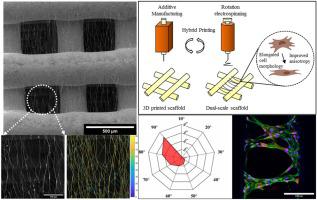Additive Manufacturing ( IF 10.3 ) Pub Date : 2020-07-15 , DOI: 10.1016/j.addma.2020.101452 Boyang Huang , Enes Aslan , Zhengyi Jiang , Evangelos Daskalakis , Mohan Jiao , Ali Aldalbahi , Cian Vyas , Paulo Bártolo

|
Large bone defects due to trauma or disease present a significant clinical challenge with limited efficacy of current therapies. A key aim is to develop biomimetic scaffolds that reflect the native tissue structure with 3D printing being an important enabling technology. However, the incorporation of multiple length scales and anisotropic features, mimicking the native architecture, is difficult with current processes. In this study, we propose a simple and versatile hybrid printing process using a screw-assisted additive manufacturing technique combined with rotational electrospinning to fabricate dual-scale anisotropic scaffolds. 3D microscale porous polycaprolactone (PCL) structures with highly aligned nanoscale fibres were successfully produced layer-by-layer. The scaffolds were morphological, mechanical and biological characterised. Human adipose-derived stem cells (hADSCs) were seeded on the hybrid scaffold to evaluate the effects of structural and anisotropic topographic cues on cell attachment, proliferation and osteogenesis differentiation. Results show that the 3D printed microscale structures have uniform and well-defined geometries and the alignment of nanoscale electrospun fibres increases by increasing the electrospinning rotational velocity. Mechanical results show that there is no significant difference between 3D printed scaffolds with or without electrospun meshes. In vitro results show higher cell seeding efficiency and proliferation in dual-scale scaffolds with high density electrospun meshes. A more stretched and elongated cell morphology was observed in aligned nanofibre scaffolds showing higher anisotropic cytoskeletal organization than 3D printed PCL scaffolds without electrospun meshes. The dual-scale scaffolds present improved overall osteogenic markers expressions (COL-1, ALP and OCN). However, no statistical difference between normalised osteogenic marker expressions were observed between dual-scale scaffolds and 3D printed scaffolds. This might be attributed to the poor bioactivity of the substrate material, PCL, suggesting topographical cues might not be sufficient to stimulate cell fate towards to an osteogenic linage. The results suggest that the proposed fabrication strategy is a promising approach for the design of novel bone scaffolds to modulate cell fates by integrating the topographic cue reported in this paper with biochemical cues associated to the use of more bioactive materials.
中文翻译:

使用3D打印和旋转静电纺丝技术设计的双尺度聚(ε-己内酯)支架,用于骨组织再生
由于创伤或疾病引起的大的骨缺损以当前疗法的有限功效提出了重大的临床挑战。一个主要目标是开发仿生支架,以反映天然组织结构,而3D打印是一项重要的使能技术。然而,在当前工艺中,难以模仿天然体系结构的多个长度尺度和各向异性特征的结合。在这项研究中,我们提出了一种简单而通用的混合印刷工艺,该工艺采用了螺丝辅助的增材制造技术并结合旋转静电纺丝技术来制造双尺度各向异性支架。具有高度对齐的纳米级纤维的3D微米级多孔聚己内酯(PCL)结构已成功逐层生产。支架的形态,力学和生物学特性。将人脂肪来源的干细胞(hADSC)播种在杂种支架上,以评估结构和各向异性地形线索对细胞附着,增殖和成骨分化的影响。结果表明3D打印的微米级结构具有均匀且定义明确的几何形状,并且纳米级电纺纤维的排列通过增加电纺丝旋转速度而增加。机械结果表明,带有或不带有静电纺网的3D打印支架之间没有显着差异。结果表明3D打印的微米级结构具有均匀且定义明确的几何形状,并且纳米级电纺纤维的排列通过增加电纺丝旋转速度而增加。机械结果表明,带有或不带有静电纺网的3D打印支架之间没有显着差异。结果表明3D打印的微米级结构具有均匀且定义明确的几何形状,并且纳米级电纺纤维的排列通过增加电纺丝旋转速度而增加。机械结果表明,带有或不带有静电纺网的3D打印支架之间没有显着差异。体外结果表明,具有高密度电纺网的双尺度支架具有更高的细胞播种效率和增殖能力。在对齐的纳米纤维支架中观察到比未电纺网状的3D打印PCL支架更高的各向异性细胞骨架组织,其细胞形态更加拉伸和伸长。双尺度支架呈现出改善的总体成骨标志物表达(COL-1,ALP和OCN)。但是,在双比例支架和3D打印支架之间未观察到标准化成骨标记物表达之间的统计学差异。这可能是由于底物材料PCL的生物活性差而引起的,这表明形貌线索可能不足以刺激细胞走向成骨线。











































 京公网安备 11010802027423号
京公网安备 11010802027423号